Albireo, Beta Cygni (β Cyg) is the primary component in a multiple star system located in the constellation Cygnus. It appears as an optical double star in small telescopes. With an apparent magnitude of 2.90, it is the fifth brightest star in Cygnus and the faintest of the stars that form the Northern Cross. Albireo lies at an approximate distance of 415 light years from Earth. It is one of the best-known contrasting double stars in the sky and a popular target for amateur astronomers.
Star system
Albireo appears as a single star to the unaided eye and is resolved into a visual binary star system in a small telescope. The two optical components are designated Beta Cygni A or Beta1 Cygni and Beta Cygni B or Beta2 Cygni. The brighter of the two – Beta Cygni A – appears yellow, while the fainter component – Beta Cygni B – appears blue. The two make one of the most striking contrasting pairs in the sky.
The two components are separated by 34.3 arcseconds, but there are uncertainties as to whether they form a physical pair or merely lie in the same line of sight. If they do form a binary system, they take at least 75,000 years to complete an orbit. However, as the stars do not share a common proper motion across the sky, this may be a chance alignment, and the stars are not gravitationally bound.
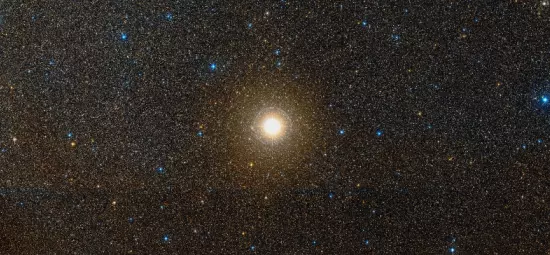
Albireo (Beta Cygni), image: Wikisky
The angular separation between the two stars has not changed in over 260 years and the position angle of Albireo B has only changed slightly. However, the stars lie at different distances. The Hipparcos mission placed Albireo A at 434 ± 20 light years from Earth and Albireo B at 401 ± 13 light years. The data from the Gaia mission indicates distances between 330 and 390 light years for both stars. However, the Gaia data is insufficient to determine whether the stars are gravitationally bound to each other.
A study published in 2021 confirmed that Albireo Aa, Ac and B are likely coeval, i.e. that they share the same origin, and that the probability of Albireo A and B being a chance alignment is very low. However, the stars are most likely unbound. The researchers proposed that the Beta Cygni system may be the residual massive core of a star cluster that has dissolved or is still dissolving. The same study found four other stars that may share a common proper motion with Albireo, all of them at a greater separation than Albireo B, but within 5 degrees of Albireo A.
Additionally, the researchers found that Albireo Ac is more massive than Albireo Aa, and suggested that the additional mass of the component Ac may be explained by the presence of an unseen companion.
The Washington Double Star Catalog (WDS) lists 10 more faint companions, none of them brighter than magnitude 10. Only one of the companions is closer to Albireo A than Albireo B, while others are scattered across an area up to 142’’ away from the primary.
Albireo A
Albireo A is a suspected quadruple star system consisting of components designated Albireo Aa, Albireo Ab, Albireo Ac, and Albireo Ad. The existence of Albireo Ab has not yet been confirmed and remains doubtful. When it was reported, the separation between Albireo Aa and Ab was 0.1’’ and now it is 0.0’’, making it impossible to resolve the pair. The discovery of Albireo Ad in 2022 makes the existence of Albireo Ab unlikely as the latter would make the system gravitationally unstable.
Albireo Aa and Albireo Ac are separated by only 0.4 arcseconds and can only be resolved in 20-inch or larger telescopes. They take about 121.65 years to complete an orbit. The physical separation between them is 48 astronomical units on average.
The maximal orbital separation between Albireo Aa and Ad is about 1.9 astronomical units, corresponding to an angular separation of 0.0157 arcseconds. Albireo Ad orbits the primary with a period of 371 days.
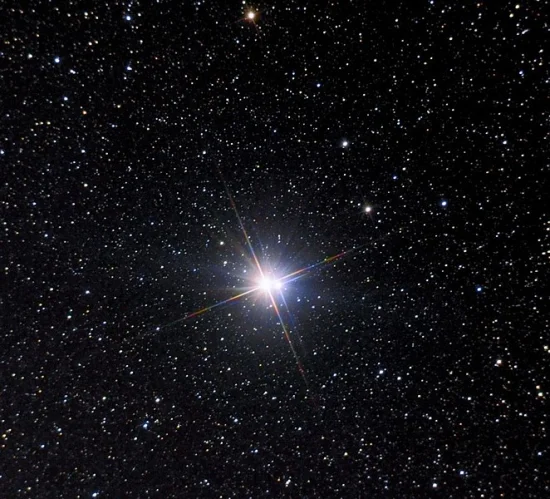
Albireo A, image: Henryk Kowalewski (CC BY-SA 2.5)
Albireo Aa
The primary component, Albireo Aa, has an apparent magnitude of 3.21 and the stellar classification K2II, indicating an orange bright giant. It is a red giant (or supergiant) star with a mass 5.2 times that of the Sun. With an effective temperature of 4,383 K, it shines with 1,259 solar luminosities. The star has a radius 62 times that of the Sun and spins with a projected rotational velocity of 8.34 km/s.
Albireo Ac
The status and properties of the companions are still not entirely clear. Albireo Ac is a blue-white main sequence star of the spectral type B8:p. It has an apparent magnitude of 5.85. The star is 2.7 times more massive than the Sun and 79 times more luminous with a surface temperature of 10,000 K. It has a radius 3 times that of the Sun.
Albireo Ad
The discovery of Albireo Ad was announced in March 2022. The low-mass star was detected using the radial velocity method and data obtained with the Heidelberg Extended Optical Range Spectrograph (HEROS) echelle spectrograph mounted on the 1.2 m Telescopio Internacional de Guanajuato Robótico Espectroscópico (TIGRE) telescope in Mexico. The star has a mass of about 0.085 solar masses.
The same study analysed the spectra of Albireo to determine the stellar parameters of Albireo Aa. The researchers obtained a radius of 55 solar radii, a rotational velocity of 4.45 km/s and a surface gravity of 1.7 assuming a mass 5.2 times that of the Sun.
Albireo B
Albireo B is a blue-white main sequence star of the spectral type B8Ve. It has an apparent magnitude of 5.11. The star has a radius 2.59 times that of the Sun and a mass of 3.7 solar masses. With a temperature of 13,200 K, it is 230 times more luminous than the Sun. The star’s estimated age is 100 million years. Unlike Albireo Aa, Albireo B is a very fast spinner, a Be star with a projected rotational velocity of at least 250 km/s at the equator. As a result, it is losing material and is surrounded by a circumstellar disk of gas.
Facts
Even though it has the Bayer designation Beta Cygni, Albireo is fainter than Sadr (Gamma Cygni), Fawaris (Delta Cygni), and Aljanah (Epsilon Cygni).
Albireo will be the brightest star in the sky around the year 3,870,000, when it comes within 80 light years of the solar system. At its peak (around the year 4,610,000), it will shine at magnitude -0.52, which is a little fainter than Canopus is today.
The spectrum of the primary star was discovered to be composite in the late 19th century, when the star was photographed with the 11-inch Draper Telescope as part of the Henry Draper Memorial project. Observations between 1898 and 1918 confirmed that it was a double star, revealing variations in the star’s radial velocity. The two components were listed as HD 183912 and HD 183913 in the Henry Draper Catalogue in 1923.
A companion was resolved at a separation of 0.125’’ in 1978 using speckle interferometry with the 1.93m telescope at the Haute-Provence Observatory (OHP) in southeast France. The companion is designated Beta Cygni Ab in the Washington Double Star Catalog.
Observations published in 1982 revealed a companion at an angular separation of 0.44’’. The star was resolved through speckle interferometry with the 2.1m telescope at the Kitt Peak National Observatory (KPNO) in Arizona in 1976. It was listed as Beta Cygni Ac in the Washington Double Star Catalog (WDS) and as Beta Cygni C in the Catalog of Components of Double and Multiple Stars (CCDM). (This is not the same component C as the one listed in the WDS; the latter is only a visual companion.) The estimated orbital period for the pair is about 214 years.
Name
The name Albireo (pronunciation: /ælˈbɪrioʊ/) comes from a misunderstanding of the words ab ireo in the description of the constellation Cygnus in the 1515 Almagest. The name is believed to have originated from the Greek word ornis, which was the name for the Cygnus constellation and later became urnis in Arabic. When the name was translated into Latin, it was mistakenly believed to refer to Erysimon, the Greek name for hedge mustard, and became ireo (Latin for hedge mustard). The words ab ireo were eventually viewed as a miscopy and changed into al-bireo.
The name was officially approved by the International Astronomical Union’s (IAU) Working Group on Star Names (WGSN) on July 20, 2016. It formally applies only to the component Beta Cygni Aa, but is informally used for the entire system and its other individual components.
In medieval Arabic astronomy, Albireo was known as Al Minhar al Dajajah, meaning “the hen’s beak.” The name referred to the star’s position in the constellation. (Albireo is still sometimes known as the “beak star,” as it marks the beak of the celestial Swan.) This name appeared in the Egyptian astronomer Al Achsasi Al Mouakket’s Calendarium in the 17th century. It was translated into Latin as Rostrum Gallinae.
Location
Albireo is very easy to find because it is relatively bright and part of a familiar summer asterism, the Northern Cross. It lies at the base of the cross, on the opposite side of the constellation to the bright Deneb, the star that marks the top of the cross and the celestial Swan’s tail. Deneb (Alpha Cygni), Sadr (Gamma Cygni) and Albireo outline the pole of the cross, while Aljanah (Epsilon Cygni) and Fawaris (Delta Cygni) form the crossbeam.
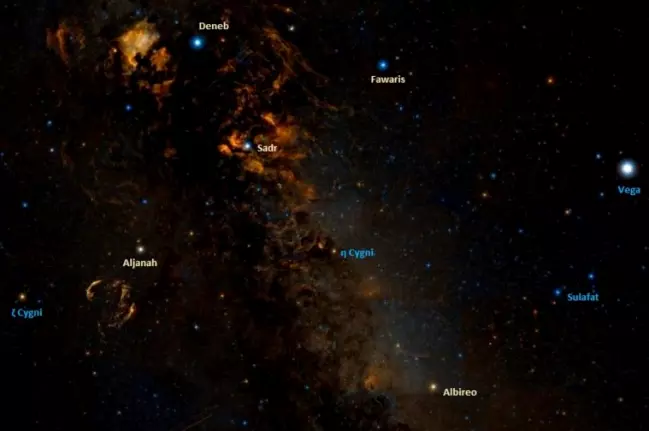
The Northern Cross, image: Wikisky
The Northern Cross is quite prominent on a clear night and lies within the borders of the Summer Triangle, a larger summer asterism formed by Deneb with Vega in the constellation Lyra and Altair in Aquila.
Albireo can be used to find Messier 56, a bright (mag. 8.3) globular cluster located in Lyra. The cluster lies about halfway between Albireo and Sulafat, slightly closer to Albireo. Sulafat is the second brightest star in Lyra and lies on the opposite side of the constellation to Vega.
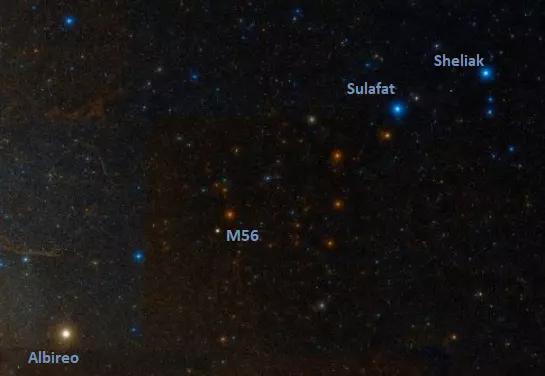
Albireo (Beta Cygni), Sulafat (Gamma Lyrae) and Messier 56, image: Wikisky
Constellation
Albireo is located in the constellation Cygnus, the Swan. Easily recognizable for the Northern Cross asterism, Cygnus is the 16th largest constellation in the sky. It is one of the Greek constellations, which first appeared in Ptolemy’s Almagest in the 2nd century CE.
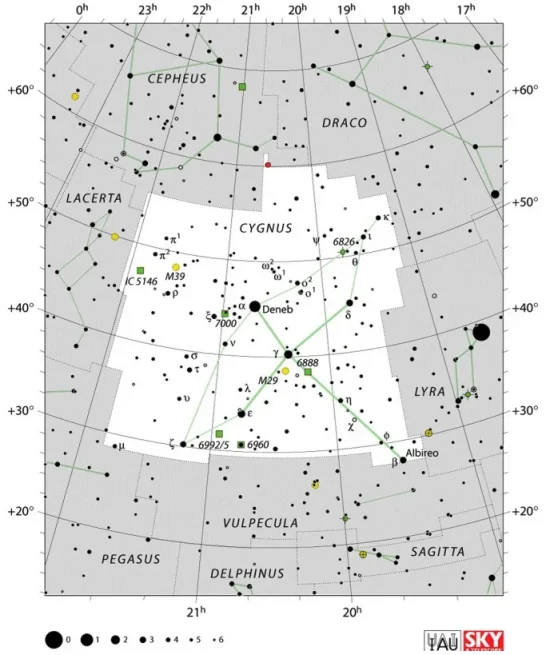
Cygnus constellation map by IAU and Sky&Telescope magazine
Cygnus is home to a number of popular telescope targets, including the double stars Fawaris and Mu Cygni, the open clusters Messier 29, Messier 39 and NGC 6910, and the bright spiral galaxy NGC 6946, also known as the Fireworks Galaxy. Bright nebulae in the constellation include the North America Nebula (NGC 7000) and the Pelican Nebula (IC 5070) near Deneb, the Crescent Nebula (NGC 6888) and the Gamma Cygni Nebula (IC 1318) near Sadr, the Veil Nebula (NGC 6960, 6962, 6979, 6992 and 6995) near Aljanah, and the Blinking Planetary Nebula (NGC 6826).
The constellation also contains the Methuselah Nebula (MWP 1), the Footprint Nebula (M1-92), the Fetus Nebula (NGC 7008), the Soccer Ball Nebula (Kronberger 61), and the Cheeseburger Nebula (NGC 7026).
The best time of year to see the stars and deep sky objects of Cygnus is during the month of September, when the constellation is high in the evening sky. For northern hemisphere observers, Cygnus is conspicuous in the night sky from June to December.
The 10 brightest stars in Cygnus are Deneb (Alpha Cyg, mag. 1.25), Sadr (Gamma Cyg, mag. 2.23), Aljanah (Epsilon Cyg, mag. 2.48), Fawaris (Delta Cyg, mag. 2.87), Albireo (Beta Cyg, mag. 2.90), Zeta Cygni (mag. 3.21), Xi Cygni (mag. 3.73), Tau Cygni (mag. 3.65 – 3.75), Iota2 Cygni (mag. 3.77), and Kappa Cygni (mag. 3.814).
Albireo – Beta Cygni
| Spectral class | K2II (Albireo Aa), B8:p (Albireo Ac), B8Ve (Albireo B) |
| Apparent magnitude | 2.90 |
| Distance (Albireo A) | 430 ± 20 light years (133 ± 6 parsecs) |
| Parallax (Albireo A) | 7.51 ± 0.33 mas |
| Radial velocity (Albireo A) | -23.54 km/s |
| Proper motion (Albireo A) | RA: -7.17 mas/yr |
| Dec.: -6.15 mas/yr | |
| Constellation | Cygnus |
| Designations | Albireo, Beta Cygni, β Cyg, 6 Cygni, CCDM J19307+2758, ADS 12540, WDS 19307+2758 |
| Beta Cygni A | HR 7417, HIP 95947, FK5 732, BD+27 3410, GC 26953, GCRV 11939, IRAS 19286+2751, 2MASS J19304330+2757347, PPM 109139, SAO 87301 |
| Beta Cygni Aa | HD 183912, TYC 2133-2964-1 |
| Beta Cygni Ab | HD 183913, TYC 2133-2964-2 |
| Beta Cygni B | HD 183914, HIP 95951, HR 7418, BD+27 3411, GC 26956, GCRV 11941, PPM 109141, SAO 87302, 2MASS J19304540+2757549, TYC 2133-2963-1, Gaia DR1 2026113335413644928, Gaia DR2 2026113339752723456 |
Albireo Aa
| Spectral class | K2II |
| B-V colour index | +1.13 |
| V-R colour index | +0.92 |
| Apparent magnitude | 3.21 |
| Absolute magnitude | -2.45 |
| Mass | 5.2 M☉ |
| Radius | 62 R☉ |
| Luminosity | 1,259 L☉ |
| Temperature | 4,383 K |
| Metallicity | -0.1 dex |
| Rotational velocity | 8.34 km/s |
| Surface gravity | 0.93 cgs |
| Right ascension | 19h 30m 43.286s |
| Declination | +27° 57′ 34.84″ |
Albireo Ac
| Spectral class | B8:p |
| B-V colour index | +0.09 |
| V-R colour index | +0.09 |
| Apparent magnitude | 5.85 |
| Absolute magnitude | -0.25 |
| Mass | 2.7 M☉ |
| Radius | 2.59 R☉ |
| Luminosity | 79 L☉ |
| Temperature | 10,000 K |
| Right ascension | 19h 30m 43.295s |
| Declination | +27° 57′ 34.62″ |
Albireo B
| Spectral class | B8Ve |
| U-B colour index | -0.32 |
| B-V colour index | -0.10 |
| Apparent magnitude | 5.11 |
| Distance | 400 ± 10 light years (123 ± 4 parsecs) |
| Parallax | 8.16 ± 0.25 mas |
| Radial velocity | -18.80 km/s |
| Proper motion | RA: -1.078 mas/yr |
| Dec.: -1.540 mas/yr | |
| Mass | 3.7 ± 0.8 M☉ |
| Luminosity | 230 ± 90 L☉ |
| Radius | 2.59 R☉ |
| Temperature | 13,200 ± 600 K |
| Age | 100 million years |
| Surface gravity | 4.00 ± 0.15 cgs |
| Right ascension | 19h 30m 45.3962s |
| Declination | +27° 57′ 54.989″ |